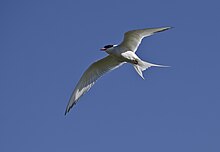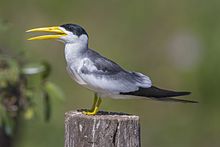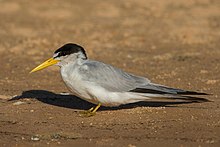Terns
| Terns | ||||||||||||
|---|---|---|---|---|---|---|---|---|---|---|---|---|

Arctic terns ( Sterna paradisaea ) |
||||||||||||
| Systematics | ||||||||||||
|
||||||||||||
| Scientific name | ||||||||||||
| Sterninae | ||||||||||||
| Bonaparte , 1838 |
The terns (Sterninae) form a subfamily within the order of the plover-like (Charadriiformes or waders and seagulls). Compared to the closely related seagulls, the terns are generally smaller, narrower and appear stockier. In addition, the terns are distinct migratory birds that overwinter in the tropics or even like the arctic tern in the Antarctic.
Appearance
Terns are about 24 to 40 cm in length, smaller than gulls. They are slimmer and, unlike the seagulls, have narrow wings, a clearly forked tail (hence the name " swallows ") and a pointed beak, which is often downward in flight. Their plumage is often white to gray. Many species have a black hood.
habitat
Most species of tern live on the coast of the sea, some species also live in inland waters. They cover very long distances to their wintering places.
Way of life
Terns nest on the ground or on rocks, often in colonies. The nests are usually very close together and can be simple bare hollows. Inland terns also build shallow nests on floating swamp vegetation .
Terns swim relatively rarely. They shake for food and dive for fish from the air.
Some species of tern show remarkable flight performance. The arctic tern native to Central Europe migrates to Antarctica after the breeding season and then returns to the north after the summer there. Some individuals cover more than 40,000 km a year.
Genera and species
The subfamily includes nine genera and 39 species .
-
Common Terns ( Chlidonias )
- Black-fronted tern ( Chlidonias albostriatus )
- Whitebeard Tern ( Chlidonias hybridus )
- White-winged tern ( Chlidonias leucopterus )
- Black Tern ( Chlidonias niger )
-
Gelochelidon
- Salmon tern ( Gelochelidon nilotica )
- Australian salmon tern ( Gelochelidon macrotarsa )
-
Hydroprogne
- Predatory tern ( Hydroprogne caspia )
-
Larosterna
- Inca tern ( Larosterna inca )
-
Onychoprion
- Aleutian tern ( Onychoprion aleuticus )
- Chinstrap ( Onychoprion anaethetus )
- Sooty Tern ( Onychoprion fuscatus )
- Spectacled Tern ( Onychoprion lunatus )
-
Phaetusa
- Great-billed tern ( Phaetusa simplex )
-
Sterna
- Black-bellied tern ( Sterna acuticauda )
- Hindu tern ( Sterna aurantia )
- Damara tern ( Sterna balaenarum )
- Rose tern ( Sterna dougallii )
- Forest Tern ( Sterna forsteri )
- Falkland Tern ( Sterna hirundinacea )
- Common tern ( Sterna hirundo )
- Peruse tern ( Sterna lorata )
- Australian tern ( Sterna nereis )
- Arctic tern ( Sterna paradisaea )
- Barnacle tern ( Sterna repressa )
- Oriental tern ( Sterna saundersi )
- Tara tern ( Sterna striata )
- Black-necked tern ( Sterna sumatrana )
- White-headed tern ( Sterna trudeaui )
- Kerguelean Tern ( Sterna virgata )
- Antipodean tern ( Sterna vittata )
-
Sternula
- Little tern ( Sternula albifrons )
- American little tern ( Sternula antillarum )
- Amazon tern ( Sternula superciliaris )
-
Thalasseus
- American sandwich tern ( Thalasseus acuflavidus )
- Rüppellseeschwalbe ( Thalasseus bengalensis )
- Common Tern ( Thalasseus bergii )
- Amber tern ( Thalasseus bernsteini )
- Ornamental tern ( Thalasseus elegans )
- King tern ( Thalasseus maxima )
- Sandwich tern ( Thalasseus sandvicensis )
Systematics
Originally the terns had the rank of an independent family (Sterninae) within the order of the plover-like (Charadriiformes). According to molecular genetic data, however, they are not a monophyletic taxon in their old composition , but are divided into three clades and, together with the gulls and scissor beaks, form a larger clade. Noddise tern (Anoinae) and fairy tern (Gyginae) were therefore separated from the terns and the three groups together with the gulls and scissors bills (Rhynchopinae) were all placed as subfamilies in the family Laridae , which originally only included the gulls.
supporting documents
- ↑ a b David W. Winkler, Shawn M. Billerman, Irby J. Lovette: Bird Families of the World: A Guide to the Spectacular Diversity of Birds. Lynx Edicions (2015), ISBN 978-8494189203 . Pages 149–151.
- ↑ Baker, AJ; Pereira, SL; Paton, TA (2007). Phylogenetic relationships and divergence times of Charadriiformes genera: multigene evidence for the Cretaceous origin of at least 14 clades of shorebirds. Biology Letters. 3: 205-209. doi: 10.1098 / rsbl.2006.0606
- ^ IOC World Bird List: Noddies, gulls, terns, auks


